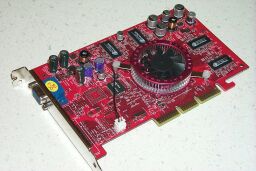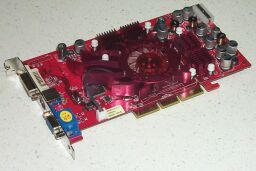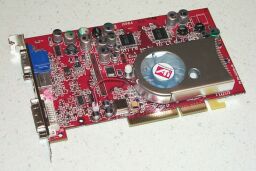| THERE'S A COUPLE OF NEW KIDS IN TOWN... |
In the spring of 2003, Nvidia & ATI both released their newest lines of mainstream graphics cards. The new Nvidia lineup is known as the "GeforceFX" series, and includes models targeted at the low end (FX 5200), mid-range (FX 5600), and high performance (FX 5900) segments of the video card market. For ATI, an analagous lineup is comprised of the Radeon 9200 (low end), 9600 (mid-range) and 9800 (high-end) cards. As usual, my personal interest in 3D gaming combined with an innate tendency to be a cheapskate makes me most interested in the middle category. This is where the value-conscious gamer will be looking--those PC owners who want some serious 3D horsepower but are not about to drop $400 on the latest "top of the line" card.
If you keep pace with developments in the video card world, you're no doubt aware that Nvidia, once the undisputed "king of the 3D hill", has been struggling of late. The emergence of ATI as a true force in 3D graphics has put Nvidia on the defensive, and it's generally recognized that the top 3D performer right now is the Radeon 9800 Pro, edging out the GeforceFX 5900 in most reviews I've seen. Before that, its precursor, the Radeon 9700 Pro, ruled the roost for many months, and the Radeon 9500 series cards gave the Nvidia Geforce4 Ti4600 and Ti4200 cards a real run for the money in the mid-range market. Consequently, the new GeforceFX cards were widely anticipated as Nvidia's attempt to return to preeminence, as well as being DirectX 9 compliant, as the Radeon 9500 and 9700 series cards had been for several months. But ATI isn't resting on its laurels, by any means, and the latest Radeon cards look to build upon their recent hot streak and keep them on top in the 3D video wars.
So, is it "mission accomplished" or "back to the drawing board" for NVidia on their latest video technology?? Does ATI maintain the performance crown or relinquish it to the former champion? Read on to discover Duh Voodoo Man's take on the situation....
| INTRODUCING THE CONTENDERS.... |
For the sake of meaningful comparison, I've selected a total of four mid-range performance video cards for this exercise. As I've stated before in studies of this kind, I will focus strictly upon 3D performance speed and quality here, and not get into evaluating other factors like VIVO, DVD playback, software bundles, etc. Those things have their place, of course, and your particular needs may make them a high priority when selecting a new video card. But I'll be concentrating on frame rates, antialiasing & anisotropic filtering impact, and overclocking performance--the things that make games and other 3D apps run fast and look good. Let's have a quick look at the four cards to be tested:
Gainward Geforce4 Ti4200:
 |
The NVidia Geforce4 Ti4200 cards have been a favorite of the value-conscious gamer for over a year now. Their popularity is well founded, as they have always been reasonably priced while still offering very competitive performance, especially when overclocked. However, they are clearly approaching the end of their market life cycle now, particularly since they do not support the latest DirectX 9 rendering technology. While this hasn't been a significant handicap yet, the new DX9 games should start hitting the shelves over the next several months, and gamers will want a card that can showcase their impressive new visual effects.
The particular card I used is a Gainward GF4 Ti4200 64MB that I originally purchased in June of 2002. You can read about the initial studies I did on this card vs. a Geforce3 Ti200 and a Radeon 8500LE in THIS ARTICLE. While only a 64MB card, I have been very happy with its performance, and it overclocks fairly well, too. Originally purchased for about $160, it can still be found at a couple of online reseller's websites for under $100. It's a "plain vanilla" card, with no TV-out or DVI connectors.
Sapphire Atlantis Radeon 9500:
 |
The Sapphire Atlantis Radeon 9500 (non-Pro) is a bit of a "ringer" in this group, because it's really two cards disguised as one. Selling originally for around $150, the 9500 and its somewhat pricier cousin, the 9500 Pro, have been the acknowledged performance-for-the-price leaders in the mid-range video card market since late 2002. The kicker here is that ATI and its partners made the decision to supply the original 9500 cards (non-Pro's only) by manufacturing them as 9700's, and then disabling half of their processing power through the video drivers! Unsurprisingly, some clever people discovered this fact and figured out how to turn the disabled half back on! You can read all about it HERE. It doesn't work for every 9500, but it does work for many...and mine was one of them!
This is the card that I run in my personal PC--as a 9700, naturally. For the sake of this study, though, I tested the card with the 9700 modification turned off as well as turned on. The former is really the fairer comparison against these other mid-range models. But the numbers from the card "softmodded" to run as a 9700 give a glimpse into how all of these cards perform versus a high-end video card. The Radeon 9500 supports DirectX 9, and this card came with TV-out and a DVI connector. It's been modified with an aftermarket Thermaltake Crystal Orb fan and heatsinks glued onto the RAM chips, though overclocking performance (unfortunately!) wasn't significantly improved.
Gainward GeforceFX 5600 Ultra/760 XP Golden Sample:
 |
The GeforceFX 5600 cards come in three basic versions: a baseline model, a faster "Ultra" version, and a high-end variant of the Ultra that uses newer "flip chip" technology for the GPU and may incorporate higher speed RAM. And even though I may be a cheapskate, I'm not above being seduced by sexy technology, so I went for the high end for this study. The FX 5600 I chose was the Gainward PowerPack! Ultra/760 XP 128MB "Golden Sample", acknowledged to be the fastest FX 5600 currently available. While it's certainly not cheap (I paid $219 at GameVE.com ), it's an impressive package. In addition to both VGA and DVI connectors, the card has full video-in, video-out (VIVO) capability, and bundled software to support it. But most impressive to me was the fact that it ships with core and memory clock settings of 400 and 800MHz, respectively, and is guaranteed by Gainward to run at 450/900 in "enhanced" mode, using their bundled "EXPERTool" performance tuning utility. This is some SERIOUS CLOCKSPEED, folks, and I was eager to see what kind of 3D performance it would translate into! Since Nvidia's default clock setting spec for the baseline FX 5600 cards is 325/550, the Ultra/760 XP's "enhanced" mode translates to about a 50% upclocking vs. the standard model. So it's fair to say that this comparison lets the FX 5600 technology put its best foot forward. If it doesn't measure up, there are no excuses to hide behind!
Powercolor Radeon 9600 Pro "Bravo" Edition:
 |
Like the FX5600, the new Radeon 9600 comes in several versions. Not only is there a base 9600 card and a higher performing "Pro", but the latter comes in several versions, as well. For this reason, it's extremely important to shop carefully and KNOW which one you're buying before you plunk down your hard-earned dinero. After one such "false start" with a Sapphire Atlantis 9600 Pro "Lite" card that turned out to use substandard memory and a weak GPU, I found the Powercolor Radeon 9600 Pro "Bravo" Edition at Monarch Computer for $180. Like the Gainward "Golden Sample" above, the Powercolor "Bravo" is a performance-enhanced variant, incorporating high quality Samsung DDR memory. This allows the card's memory to be factory-set at 675MHz vs. 600MHz for a standard 9600 Pro. Default clockspeed on the GPU is per the standard 9600 Pro spec of 400MHz (well, 398, actually), but these new RV350 Radeon cores use ATI's latest 0.13 micron fabrication technology and are well known to be wicked overclockers. (We'll give the card plenty of chance to show what it can do in that regard later!) Though there isn't any video-in capability, the "Bravo" offers TV-out and DVI connectors along with the standard VGA port. The software bundle is much better than average, with WinDVD decoding software and the full version of "Tomb Raider: Angel of Darkness", along with some other older games. All in all, it should prove a worthy adversary to the hot Gainward FX 5600 Ultra.
That covers the basics on the video cards to be tested, so let's move on to the testing scheme itself....
